|
page one
BIG CALIFORNIA DRAGONS
|
|
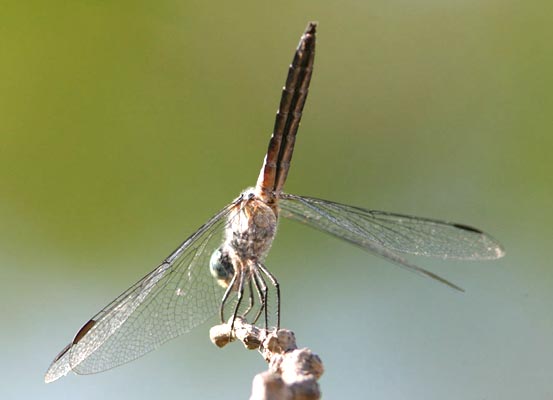 My
wife Rita and I are birders. In June 2006 we knew nothing about dragonflies.
Yet there is something about a hot summer afternoon, when birds are few
but dragonflies are buzzing, that turns one's attention to these marvelous
insects in the order Odonata (often called "odes" or "odonates"). It was
during a tour through the foothills of northern California that these dragons
first caught our attention. My
wife Rita and I are birders. In June 2006 we knew nothing about dragonflies.
Yet there is something about a hot summer afternoon, when birds are few
but dragonflies are buzzing, that turns one's attention to these marvelous
insects in the order Odonata (often called "odes" or "odonates"). It was
during a tour through the foothills of northern California that these dragons
first caught our attention.
The single dragonfly that first sparked an interest is this one (right
& below). It seemed to dominate a little reedy pond north of Chico,
Butte County, on 20 July 2006. Using Tim Manolis's 2003 book
Dragonflies
and Damselflies of California, we tentatively identified it as "Comanche
Skimmer Libellula comanche.," and thus made our first dragonfly
identification mistake. Swing-and-a-miss; strike one. [I would strike out
several times in subsequent months.]
Ray Bruun, who has an incredible set
of dragonfly photos from northern California, suggested the correct
answer: Blue Dasher Pachydiplax longipennis. It seemed
big as dragonflies go — it is listed at 1.5 inches long and 2.5 inches
in wingspan (but there are bigger ones). In the photo below, note the clear
wings (we can see right through them) with a cream-colored pterostigma
[that small opaque patch near the leading edge of the wingtip on the near
wing; Comanche Skimmer actually has a strikingly two-tone black-and-white
pterostigma]; the bluish pruinescence (a powdery substance) on top of the
abdomen but striped below (right); and the green eyes with a white face.
It is perched in an "obelisk" position, pointing the tip of the abdomen
towards the sun as a thermoregulation device (Manolis 2003). |
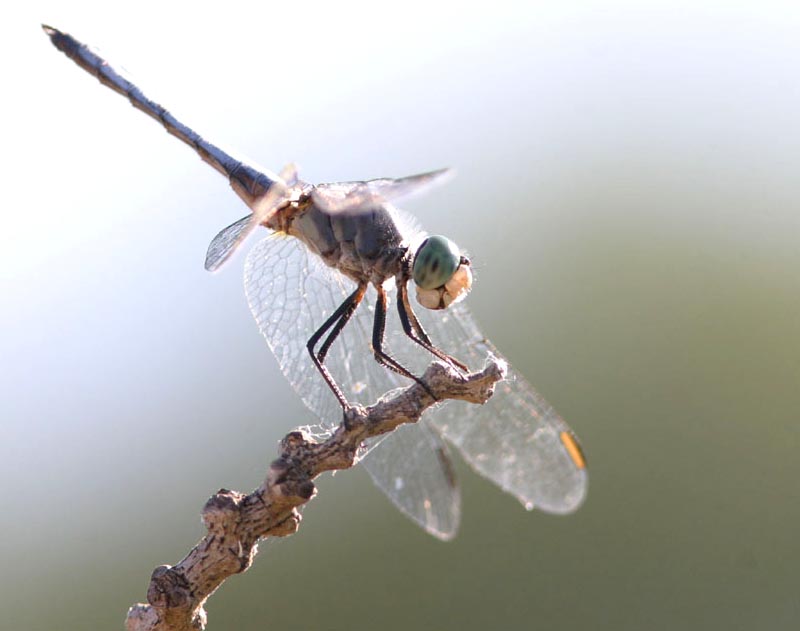
|
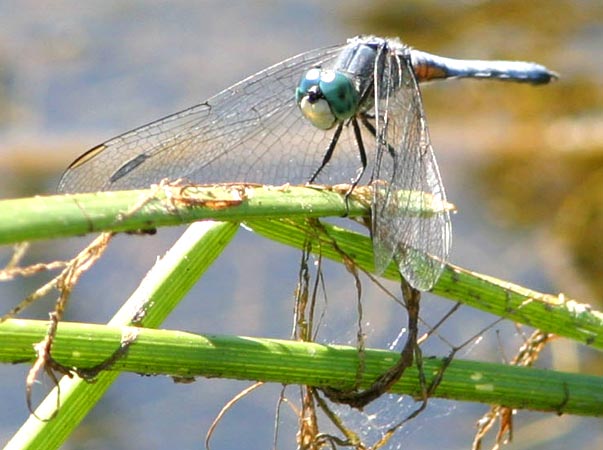 We
would run into the Blue Dasher again, this time holding a more typical
perched position with the wings held forward and down (right), a couple
weeks later in Monterey County. This time the male was on a small stock
pond at Hastings Natural History Reservation in upper Carmel Valley. This
is a widespread species in the U.S. and southern Canada. Manolis (2003)
says that "Blue Dashers actively sally for small prey, returning repeatedly
to the same perch after making a capture. They look very alert on perch,
seeming to lean forward with the abdomen cocked up and the wings swept
forward or up and back. Males occupy low perches over or near water and,
where densities are high, engage in frequent territorial skirmishes for
preferred sites." We
would run into the Blue Dasher again, this time holding a more typical
perched position with the wings held forward and down (right), a couple
weeks later in Monterey County. This time the male was on a small stock
pond at Hastings Natural History Reservation in upper Carmel Valley. This
is a widespread species in the U.S. and southern Canada. Manolis (2003)
says that "Blue Dashers actively sally for small prey, returning repeatedly
to the same perch after making a capture. They look very alert on perch,
seeming to lean forward with the abdomen cocked up and the wings swept
forward or up and back. Males occupy low perches over or near water and,
where densities are high, engage in frequent territorial skirmishes for
preferred sites." |
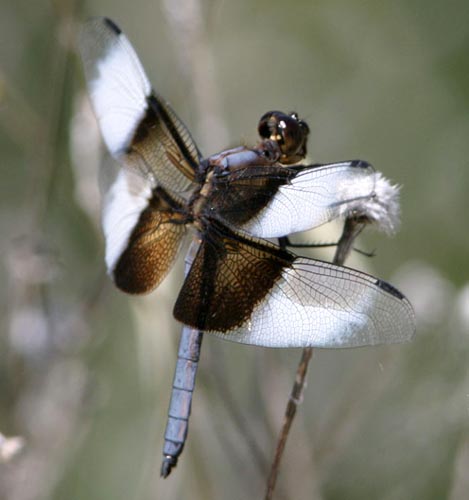 |
Another very impressive, large dragonfly encountered that same trip
through northern California was this Widow Skimmer Libellula
luctuosa. This is a widespread dragon across the United States but
has apparently expanded into northern California within the last century
(Manolis 2003). It like artificial bodies of water — this one was among
many on a farm stock pond in Glenn County, just north of Stonyford (Colusa
Co.) on 18 June 2006. Each male was busily defending a patch of emergent
reeds. |
|
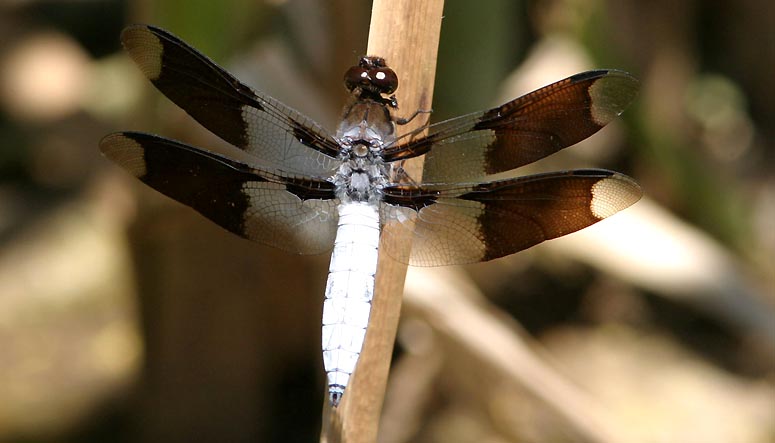
|
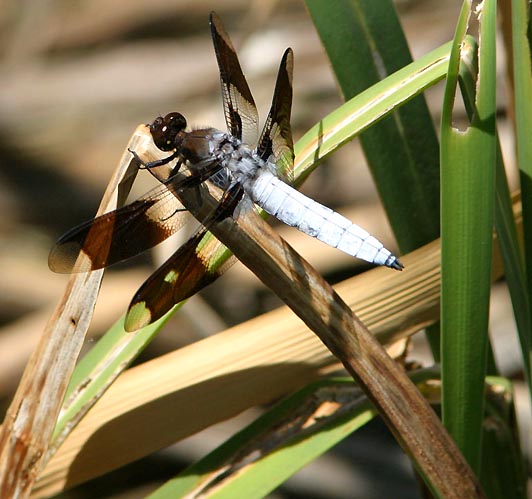 The
final 'big dragon' we ran into on our June 2006 trip up north was Common
Whitetail Plathemis lydia [sometimes called White-tailed Skimmer],
above and right. We found many males defending little territories around
the edges of the Hayfork sewage ponds, Trinity County, on 19 June. It is
a black-and-white-winged skimmer, like the previous species, but note that
the distribution of black-and-white is very different. The English name
comes from the chalky white pruinescence on the abdomen. According to Manolis
(2003), it is "one of the most familiar and widely distributed dragonflies
in the United States." The
final 'big dragon' we ran into on our June 2006 trip up north was Common
Whitetail Plathemis lydia [sometimes called White-tailed Skimmer],
above and right. We found many males defending little territories around
the edges of the Hayfork sewage ponds, Trinity County, on 19 June. It is
a black-and-white-winged skimmer, like the previous species, but note that
the distribution of black-and-white is very different. The English name
comes from the chalky white pruinescence on the abdomen. According to Manolis
(2003), it is "one of the most familiar and widely distributed dragonflies
in the United States."
Rita and I learned several weeks later that Walt Koenig had studied
this species at Hastings Natural History Reservation in upper Carmel Valley,
Monterey County (see Koenig & Albano 1987). On 1 July we joined Walt
to a favored pond and watched males defend territories by constantly patrolling
them, and chase any female that came into a territory for a brief mating
session on the wing. The female then immediately dips down to the water
surface and thrusts in her abdomen to lay eggs while the male defends the
air above her from other males wishing to mate that very instant. It makes
for a a very dramatic moment at the otherwise quiet little pond. |
|
|
| There are some very nice web pages featuring dragonflies. Some of those
that focus on California are:
And for a broader spectrum of North American odonates:
|
Literature cited:
Koenig, W.D., and S.S. Albano. 1987. Lifetime reproductive
success, selection, and the opportunity for selection in the white-tailed
skimmer Plathemis lydia (Odonata: Libellulidae). Evolution 41: 22-36.
Manolis, T. 2003. Dragonflies and Damselflies of California. Calif.
Natural Hist. Guide 72. Univ. of Calif., Berkeley, CA.
|
PHOTOS: All photos are © 2006 Don Roberson; all rights
reserved.
TOP
RETURN
TO ODONATA PORTAL PAGE
TO LIST OF BIRD
FAMILIES OF THE WORLD
TO MONTEREY COUNTY
PAGE
TO HOME PAGE
|